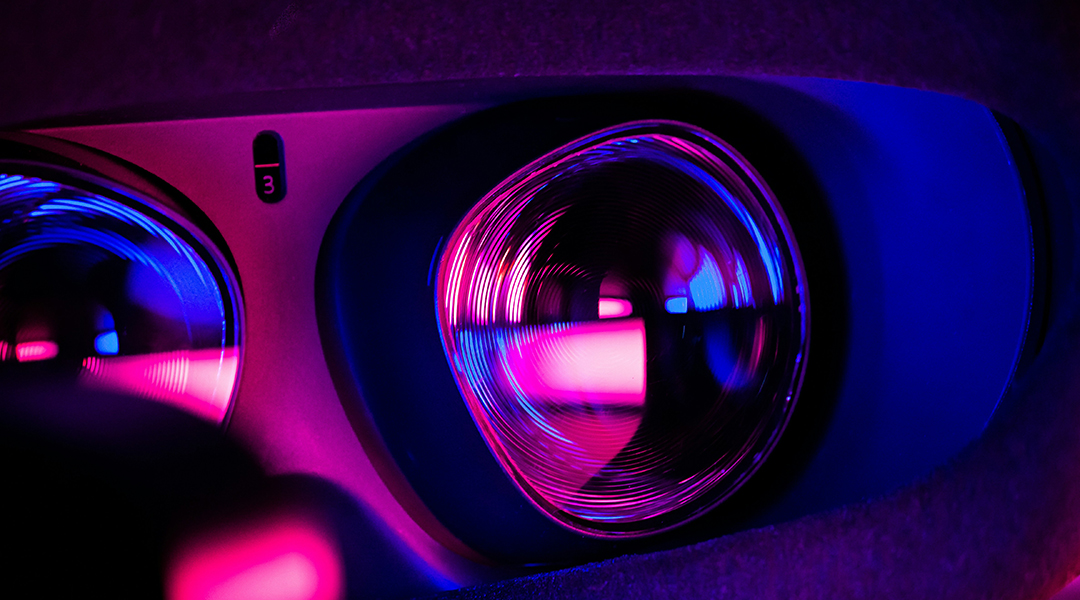Scientists have developed contact lenses that project 3D holograms using specialized nanostructures embedded on them, known as metasurfaces.
Metamaterials, in general, are engineered materials with properties not found in nature. A metasurface, as the name suggests, is a type of metamaterial simply applied to a surface. These structures are often smaller than the wavelengths of light, enabling them to manipulate electromagnetic waves, such as light and sound, in a unique way.
“[Metasurfaces] manipulate light […] with high precision,” explained the Advanced Science study’s author, Junsuk Rho at the Pohang University of Science and Technology in South Korea.
Why metasurfaces?
Metasurfaces have been useful in areas like biomedicine, speech recognition, and energy harvesting, but integrating them into contact lenses for virtual and augmented reality remains difficult. However, the potential they hold to surpass current technologies in significant ways makes them compelling.
“These augmented reality contact lenses [would] offer several significant advantages over existing technologies,” Rho explained. “Usually, there are gratings, prisms, or mirrors for delivering a virtual image from a display source located near the temple to the retina. At the same time, the light of the real-scene must be free from unwanted diffraction effects. Due to the complexity of these design requirements, the optical system is bulky.
“Because the lenses are worn directly on the eye, they preserve the natural field of view, providing an unparalleled level of immersion without the limitations imposed by external devices, like headsets or glasses.”
Outside of entertainment and gaming, there are boundless applications, from environmental monitoring, identity recognition, diagnosis, and real-time navigation, providing directions and contextual information directly in the user’s field of view.
“In settings, such as healthcare, the lenses could assist medical professionals by overlaying vital information during procedures,” Rho said. “Additionally, the lenses could serve personal health monitoring purposes, displaying real-time biometric data.”
But before any of this can come to fruition, barriers inherent in metasurface production need to be overcome. “First, ensuring the biocompatibility of the materials is critical, as contact lenses interact directly with the eye,” said Rho. “Traditional nanostructure transfer methods [for their production] often do not account for long-term biocompatibility, raising concerns about safety during extended wear.
“Second, maintaining structural stability is difficult due to the flexible and moist nature of contact lenses, which can lead to deformation or damage of the nanostructures. And finally, achieving precise pattern transfer on a flexible substrate like a contact lens is technically challenging.”
Producing metasurfaces for contacts
These hurdles only motivated Rho who has been working in this area since 2008. “I saw a news story about an ‘invisibility cloak’ being realized using metamaterials,” he said. From there, his research has expanded to include reality displays.
He and his team were motivated to overcome challenges around embedding metamaterials into contacts by developing a new production method. Their approach relies on hyaluronic acid, a naturally occurring molecule found throughout the body, particularly in the eyes, joints, and skin.
“We use it as a soft mold that allows for the gentle transfer of complex nanostructures onto the lens surface without compromising the structural integrity of the metasurface,” explained Rho. “It plays a crucial role in both the biocompatibility and functionality of the contact lenses.”
Metasurfaces are usually created using advanced fabrication techniques like photolithography or electron beam exposure. These methods involve coating a surface with a light-sensitive material, exposing it to light or electrons through a mask, and developing the pattern.
After this, additional desired materials, like semiconductors for electronics, are deposited onto the patterned substrate and etched away to form the final nanostructures that are small enough to alter or shape electromagnetic radiation. Once the metasurface is complete, it is transferred from the temporary substrate to the final material, such as a contact lens.
In the current study, the team’s fabrication process involved depositing gold onto a flexible, rubber-like material called polyurethane acrylate, which acts as the first mold for the fabricated surface. This 3D-patterned gold layer is then transferred from this initial mold to a second, hydrated hyaluronic acid film –for its final transfer onto the contact lens — that is then protected with a silicon capping layer.
“The SiO2 capping layer, situated between the contact lens material and the gold patterns, prevents direct contact with the eye, thereby minimizing any potential risk of adverse effects,” wrote the team in their paper.
The silicon layer also acts as a waveguide that directs electromagnetic waves from one point to another, not only enhancing the lens’ stability, but overall performance.
Static holograms are just the beginning…
Now comes the fun part: creating holograms using the metasurfaces embedded in the new lenses. When light hits the metasurface — this could be from a controlled light source from a wearable device or perhaps even sunlight — each tiny, carefully crafted component changes the light’s intensity, angle, and direction to create the holographic image that you can see, explained Rho.
In this iteration of the technology, the images are static, but the team has plans to further develop this. Dynamic holographic videos could one day be generated by embedding a metasurface designed to function as a diffuser, and light source such as micro-LED into the contact lens, Rho said.
Before any of this, safety needs to be thoroughly assessed and the technology developed further. “Next steps include extensive live testing to assess the long-term safety and performance of the lenses in real-world conditions,” said Rho.
“Additionally, we plan to refine the manufacturing process to ensure scalability and cost-effectiveness for commercial production,” he continued. |Regulatory approvals will also be a critical step, as we will need to demonstrate compliance with safety standards for medical devices.”
Reference: Jun-Ho Jeong, Inkyu Park, Junsuk Rho, et al.,Metasurface-Embedded Contact Lenses for Holographic Light Projection, Advanced Science (2024). DOI: 10.1002/advs.202407045
Feature image credit: James Yarem on Unsplash

















